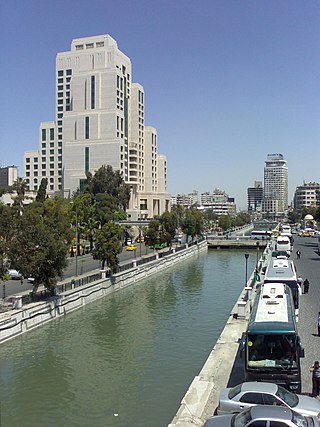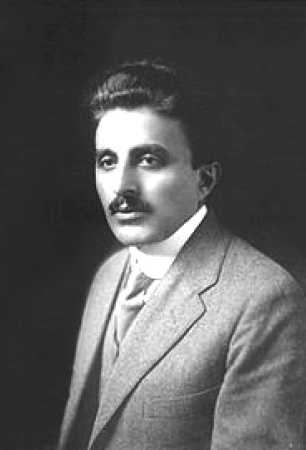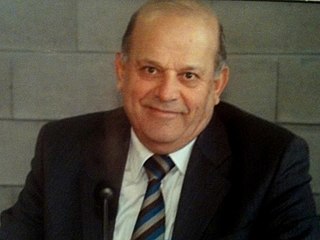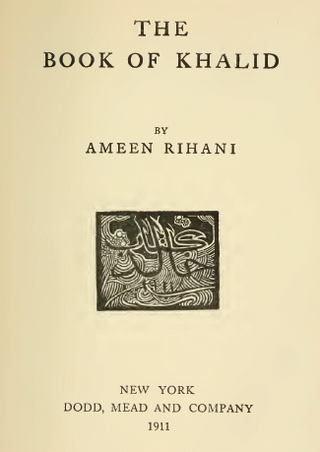
Gibran Khalil Gibran, usually referred to in English as Kahlil Gibran, was a Lebanese-American writer, poet and visual artist; he was also considered a philosopher, although he himself rejected the title. He is best known as the author of The Prophet, which was first published in the United States in 1923 and has since become one of the best-selling books of all time, having been translated into more than 100 languages.

The Barada is the main river of Damascus, the capital city of Syria.

Ameen Rihani (Amīn Fāris Anṭūn ar-Rīḥānī), was a Lebanese American writer, intellectual and political activist. He was also a major figure in the mahjar literary movement developed by Arab emigrants in North America, and an early theorist of Arab nationalism. He became an American citizen in 1901.
Youssef Saadallah Howayek (1883–1962) was a painter, sculptor and writer from Helta, in modern-day Lebanon.

Mansour Eid (1944–2013) was a Lebanese writer, novelist, researcher and poet. Born in Bteddine El Loqch, a village of the Jezzine district in southern Lebanon on 12 February 1944. He completed his secondary studies in Our Lady of Mashmoushe School. He received a degree in Philosophical & Social Studies from Arab Beirut University and a degree in Arabic Literature from the Lebanese University and a PHD degree in Arabic Literature from Saint Joseph University.
The following is a list of works by Ameen Rihani

The Book of Khalid (1911) is a novel by Arab-American writer Ameen Rihani. Composed during a sojourn in the mountains of Lebanon, it is considered to be the first novel by an Arab-American writer in English. His contemporary, Khalil Gibran, illustrated the work, and the story is often seen as an influence on Gibran's own well-known book The Prophet.

Little Syria was a diverse neighborhood that existed in the New York City borough of Manhattan from the late 1880s until the 1940s. The name for the neighborhood came from the Arabic-speaking population who emigrated from Ottoman Syria, an area which today includes the nations of Lebanon, Syria, Jordan, Israel, and Palestine. Also called the Syrian Quarter, or Syrian Colony in local newspapers it encompassed a few blocks reaching from Washington Street in Battery Park to above Rector Street. This neighborhood became the center of New York's first community of Arabic-speaking immigrants. In spite of this name the neighborhood was never exclusively Syrian or Arab, as there were also many Irish, German, Slavic, and Scandinavian immigrant families present.

The Book of Mirdad is an allegorical book of philosophy by Lebanese author Mikha'il Na'ima. The book was first published in Lebanon in 1948 and was initially written in English, with Na'ima later translating it into Arabic. Na'ima initially sought to have the book published in London, where it was rejected for "[advancing] a religion with 'a new dogma'".

Bekaa Kafra is a Lebanese village located in the Bsharri District in Northern Lebanon. Bekaa Kafra is located in front of the village of Bsharri across the Kadisha Valley. It is the birth town of Saint Charbel. Bekaa Kafra has an altitude ranging from 1500 m to 2000 m at its highest point, making it the highest village in Lebanon and one of the highest in the Middle East.

Ameen Albert Rihani is a university professor, scholar and administrator. He is a professor of Arab American literature at Notre Dame University - Louiaze. He was the Vice President of Academic Affairs since 1997. In 2013 he became advisor to the President of NDU and the Secretary General of the Institute of Lebanese Thought.

Naoum Mokarzel was an influential intellectual and publisher who immigrated to the United States from the Mount Lebanon Mutasarrifate.
Wadi Barada is a river valley in southwestern Syria. The valley is home to 17 villages and towns.
The Syrian–Mount Lebanon Relief Committee was an organization "formed in June of 1916 under the chairmanship of Najib Maalouf and the Assistant Chairmanship of Ameen Rihani" in the United States. Kahlil Gibran was its secretary. Its offices were at 55 Broadway, New York. It aimed at working in cooperation with the American Committee for Armenian and Syrian Relief, and raised "some $165,815 in two and a half years from about 15,000 Syrian subscribers in America."

Meraat-ul-Gharb is an Arabic-language newspaper founded and published in New York City by Najeeb Diab in 1899. By 1911, it was considered "the best Arabic newspaper" published in the United States. In 1908, Meraat-ul-Gharb was reported to be "one of the instruments which incited the Turkish military to its recent revolt" against the Ottoman Sultan's Government.
Emily Fares Ibrahim (1914–2011) was an American-born Lebanese writer, poet, and feminist. She was the first woman to run for the elections in Lebanon. Also, she became a notable face of the Lebanese Social Movement.
Mohammed Wajih Sobhi Fanous, was a Lebanese literary critic, academic, and researcher. He wrote about twenty books, ranging from literary criticism, cultural heritage, Islamic civilization, and contemporary themes. Some of his works have been translated into French. He held a number of cultural, intellectual, and academic positions, and was honored on several occasions.

The 1940 Nobel Prize in Literature was not awarded when the Nobel committee's deliberations were upset by the start of World War II on September 1, 1939. Instead, the prize money was allocated with 1/3 to the Main Fund and with 2/3 to the Special Fund of this prize section. This was the fourth occasion in Nobel history that the prize was not conferred.













